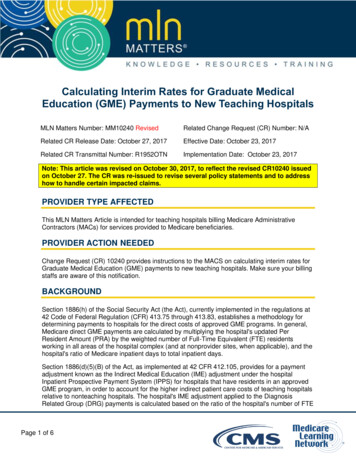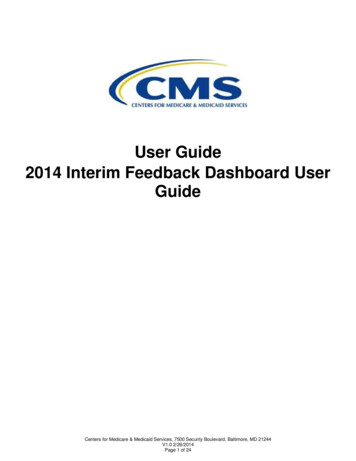
Transcription
MLN Matters MM10240Related CR 10240Calculating Interim Rates for Graduate MedicalEducation (GME) Payments to New Teaching HospitalsMLN Matters Number: MM10240 RevisedRelated Change Request (CR) Number: N/ARelated CR Release Date: October 27, 2017Effective Date: October 23, 2017Related CR Transmittal Number: R1952OTNImplementation Date: October 23, 2017Note: This article was revised on October 30, 2017, to reflect the revised CR10240 issuedon October 27. The CR was re-issued to revise several policy statements and to addresshow to handle certain impacted claims.PROVIDER TYPE AFFECTEDThis MLN Matters Article is intended for teaching hospitals billing Medicare AdministrativeContractors (MACs) for services provided to Medicare beneficiaries.PROVIDER ACTION NEEDEDChange Request (CR) 10240 provides instructions to the MACS on calculating interim rates forGraduate Medical Education (GME) payments to new teaching hospitals. Make sure your billingstaffs are aware of this notification.BACKGROUNDSection 1886(h) of the Social Security Act (the Act), currently implemented in the regulations at42 Code of Federal Regulation (CFR) 413.75 through 413.83, establishes a methodology fordetermining payments to hospitals for the direct costs of approved GME programs. In general,Medicare direct GME payments are calculated by multiplying the hospital's updated PerResident Amount (PRA) by the weighted number of Full-Time Equivalent (FTE) residentsworking in all areas of the hospital complex (and at nonprovider sites, when applicable), and thehospital's ratio of Medicare inpatient days to total inpatient days.Section 1886(d)(5)(B) of the Act, as implemented at 42 CFR 412.105, provides for a paymentadjustment known as the Indirect Medical Education (IME) adjustment under the hospitalInpatient Prospective Payment System (IPPS) for hospitals that have residents in an approvedGME program, in order to account for the higher indirect patient care costs of teaching hospitalsrelative to nonteaching hospitals. The hospital's IME adjustment applied to the DiagnosisRelated Group (DRG) payments is calculated based on the ratio of the hospital's number of FTEPage 1 of 6
MLN Matters MM10240Related CR 10240residents training in the inpatient and outpatient departments of the IPPS hospital (and atnonprovider sites, when applicable), to the number of inpatient hospital beds. This ratio isreferred to as the IME Intern-and-Resident-to-Bed (IRB) ratio.Under section 1886(h)(4)(F) of the Act, for cost reporting periods beginning on or after October1, 1997, a hospital's unweighted FTE count of residents for purposes of direct GME may notexceed the hospital's unweighted FTE count for direct GME in its most recent cost reportingperiod ending on or before December 31, 1996. Under section 1886(d)(5)(B)(v) of the Act, asimilar limit based on the FTE count for IME during that cost reporting period is applied effectivefor discharges occurring on or after October 1, 1997. Dental and podiatric residents are notincluded in this statutory cap.Section 1886(h)(4)(H)(i) of the Act requires the Secretary to establish rules for calculating thedirect GME caps for new teaching hospitals that are training residents in new medical residencytraining programs established on or after January 1, 1995. Under section 1886(d)(5)(B)(viii) ofthe Act, such rules also apply to the establishment of a hospital's IME cap on the number ofFTE residents training in new programs. The Centers for Medicare & Medicaid Services (CMS)implemented these statutory requirements in rules published in the following Federal Registers - August 29, 1997 (62 FR 46002 through 46008), May 12, 1998 (63 FR 26323 through 26325and 26327 through 26336), and August 27, 2009 (74 FR 43908 through 43919).Current Regulations on New Program CapsGenerally, under existing regulations at 42 CFR 413.79(e)(1) (for direct GME) and 42 CFR412.105(f)(1)(vii) (for IME), if a hospital did not train any allopathic or osteopathic residents in itsmost recent cost reporting period ending on or before December 31, 1996, and it begins toparticipate in training residents in a new medical residency training program (allopathic orosteopathic) on or after January 1, 1995, the hospital's unweighted FTE resident cap (whichwould otherwise be zero) may be adjusted based on the sum of the product of the highestnumber of FTE residents in any program year during the fifth year of the first new program'sexistence at all of the hospitals to which the residents rotate, the minimum accredited length foreach type of program, and the ratio of the number FTE residents in the new program thattrained at the hospital over the entire 5-year period to the total number of FTE residents in theprogram that trained at all hospitals over the entire 5-year period. The number of FTE residentcap slots that a teaching hospital receives for each new program may not exceed the number ofaccredited slots that are available for each new program. See the August 31, 2012 FederalRegister (77 FR 53416) for details on how the cap calculation is made. Similar regulationsapply for IME at 42 CFR 412.105(f)(1)(vii). In the August 22, 2014, Federal Register (79 FR50104 through 50111), CMS again revised the regulations at 42 CFR 413.79(e)(1) for directGME and 42 CFR 412.105(f)(1)(v)(D) for IME, to state that if a hospital begins training residentsin a new program on or after October 1, 2012, the hospital’s FTE caps will take effect with thebeginning of the hospital’s cost reporting period that coincides with or follows the start of thesixth program year of the first new program started. Also, under 42 CFR 413.79(d)(5) for directGME and 42 CFR 412.105(f)(1)(v) and 412.105(a)(1)(ii) for IME, FTE residents in new programsare exempt from the application of the 3-year rolling average and the IME intern-and-residentto-bed (IRB) ratio cap. For programs started after October 1, 2012, these exemptions areapplicable during the cost reporting periods prior to the beginning of the cost reporting periodPage 2 of 6
MLN Matters MM10240Related CR 10240that coincides with or follows the start of the sixth program year of the first new program started,in which the FTE cap is established.Establishment of a Direct GME (DGME) Per Resident Amount (PRA)Under section 1886(h)(3) of the Act, and implemented at 42 CFR §413.77(e)(1), if a hospital didnot previously have a PRA established, but begins training in a cost reporting period beginningon or after July 1, 1985, the MAC establishes a PRA effective with the hospital’s first costreporting period in which it participates in Medicare and has residents on duty during the firstmonth of that cost reporting period. Effective for cost reporting periods beginning on or afterOctober 1, 2006, if a hospital did not have residents on duty during the first month of that period,the MAC establishes a PRA using the information from the first cost reporting periodimmediately following the cost reporting period during which the hospital participates inMedicare and residents began training at the hospital.As 42 CFR §413.77(e)(1) states, any GME costs incurred by the hospital in the cost reportingperiod prior to the PRA base period are reimbursed on a reasonable cost basis. For example, ahospital with a January 1 to December 31 cost reporting period starts to train residents in anapproved residency program for the first time on July 1, 2017. The residents continue to train atthe hospital in January 2018 and after. The hospital’s PRA would be established from andeffective for direct GME payment during the January 2018 through December 2018 cost report,and the hospital would be paid based on Medicare’s share of the reasonable GME costs in theJanuary 2017 through December 2017 cost report.In order for a PRA to be established, the residents need not be in a newly approved residencyprogram, nor must the hospital be the sponsor, nor incur costs. Rather, a hospital counts therespective share of the FTE resident that trains in its hospital, whether it employs the resident ornot. (See the September 4, 1990 Federal Register, 55 FR 36064-5, which explains thatregardless of who employs the resident, each hospital would count the proportion of FTE timespent at its facility, both for the direct GME PRA base year, and in the payment years, while thehospital that incurs the costs of the resident in any year would claim those costs on its costreport). The MAC shall calculate and finalize the hospital’s final PRA as part of the settlement ofthe base year cost report. See below for instructions for establishing an interim rate PRA forpurposes of paying the hospital an interim direct GME payment amount from approximately thetime it starts to train residents in an approved program.Resources for determining weighted average PRA include: –67 FR 50067 through 50069(August 1, 2002); Determining hospital cost per FTE -- 54 FR 40286 (September 29, 1989), 55FR 36063 through 36065 (September 4, 1990), HCFA Memorandum, BPO-F12, November 8,1990, Questions and Answers Pertaining to Graduate Medical Education.When to Establish Interim Rates for a New Teaching Hospital Participating in a NewProgram(s)When a hospital that does not have FTE caps and/or a PRA approaches its MAC and requestsin writing (email is sufficient) IME and DGME payments due to training residents for the first timePage 3 of 6
MLN Matters MM10240Related CR 10240in a new approved GME residency program, the MAC shall, in accordance with the regulationsgoverning interim rate reviews at 42 CFR §412.116(c) and 42 CFR §413.60 and 42 CFR§413.64(a) through (e) Use the policy guidance in CR10240 to verify that the hospital does not already have aPRA and/or FTE resident caps established, and the hospital is actually training residents in anew approved program. (Refer to the August 27, 2009 FR, page 43908, to determine if anapproved program meets the “new” criteria). Establish interim IME and DGME payment rates for the hospital at the earliest scheduledrate review after the hospital submits a written request for payment. MACs need notperform a special rate review exclusively for establishing interim IME and DGME rates;rather, MACs may choose to wait until the next regularly scheduled rate review followingreceipt of the written request from the hospital, and establish interim rates for IME andDGME payments at that time.Alternatively, if the hospital is training residents for the first time but the residents are in anexisting program, and the new teaching hospital has received IME and/or DGME cap slots fromanother hospital under a Medicare GME affiliation agreement (under 42 CFR 413.79(f)), if thehospital requests in writing (email is sufficient) IME and DGME payments, the MAC shall Establish interim IME and DGME rates for the hospital in accordance with the regulationsgoverning interim rate reviews at 42 CFR 412.116(c) and 42 CFR 413.60 and 42 CFR 413.64(a)through (e). A hospital must provide the necessary documentation (discussed below) in order for the MAC toestablish the interim rates.Documentation Required for Calculating Interim IME and DGME Rates for a NewTeaching HospitalIf a hospital requests in writing (email is sufficient) that a MAC establish interim IME and DGMErates due to training residents for the first time in either new or existing approved program(s),the MAC shall request the following documentation from the hospital:For IME and DGME:Page 4 of 6 Formal accreditation letter or proof of accreditation of the applicable program(s) by therelevant accrediting body. Number of accredited positions being trained in the program for the relevant cost reportingyear for which interim rates are being established Rotation schedules, or similar documentation, indicating where the residents are training,from which to develop estimated FTE counts applicable to the requesting hospital. For IME,
MLN Matters MM10240Related CR 10240FTE residents training in locations specified in the regulations at 42 CFR §412.105(f)(1)(ii)(A)—(E) may be counted. For DGME, FTE residents training in accordance with theregulations at 42 CFR §413.78 may be counted. The MAC shall ensure that the number ofFTE residents based on which the hospital is paid in a year does not exceed the number ofaccredited slots available to the hospital for the particular program year. If applicable, a copy of the Medicare GME Affiliation Agreement under 42 CFR §413.79(f).For IME: Available bed count from the most recently submitted cost report, but modified if appropriateas part of the current interim rate review. Determine the available bed count in accordancewith the instructions on the Medicare cost report, CMS Form 2552-10, Worksheet E, Part A,line 4. Timely submission of claims for receipt of IME payments on behalf of inpatient servicesprovided to Medicare Fee for Service and Medicare Advantage beneficiaries, in accordancewith 42 CFR 424.30 and 424.44.For DGME: Medicare utilization – Determine the hospital’s Medicare utilization rate (or ratio of Medicareinpatient days to total inpatient days) in accordance with the instructions on the Medicarecost report, CMS Form 2552-10, Worksheet E-4, lines 26, 27, and 28, columns 1 and 2 forPart A and Part C, using the hospital’s most recently submitted cost report (but modified asappropriate as part of the current interim rate review). Timely submission of claims for receipt of IME payments on behalf of inpatient servicesprovided to Medicare Fee for Service and Medicare Advantage beneficiaries, in accordancewith 42 CFR 424.30 and 424.44. For the PRA, see below.Calculating an Interim Rate PRAUnder 42 CFR §413.77(e)(1)(i) and (ii), a new PRA is equal to the lower of the hospital’s actualcost per resident incurred in the base period, or the weighted mean average PRA of all of theother existing teaching hospitals located in the same core-based statistical area (CBSA) as thenew teaching hospital. Under 42 CFR §413.77(e)(1)(iii), if under §413.77(e)(1)(ii)(A) or (B)there are less than 3 existing teaching hospitals with PRAs located in the same CBSA as thenew teaching hospital with PRAs that can be used for the weighted average PRA calculation,the census region PRA is used (updated for inflation to the new teaching hospital’s base yearcost reporting period).Since the hospital’s actual cost per FTE resident information would not be available until thehospital files its base year cost report, and since determination of the weighted average PRA forthe CBSA can be labor intensive, the MAC shall use the latest available census region PRAPage 5 of 6
MLN Matters MM10240Related CR 10240issued by CMS for the census region in which the new teaching hospital is located, updated forinflation to the base period of the new teaching hospital, for the purpose of calculating andpaying DGME interim rates. However, once the hospital submits its base year cost report, theMAC shall calculate and assign the appropriate PRA to the new teaching hospital (as part of thenormal cost report settlement process for the new teaching hospital). The MAC shall calculatethe interim rate subsequently using the hospital’s permanently assigned PRA, updated withinflation.The MAC shall update the IME field in its file and establish a direct GME pass-through paymentto reflect the appropriate interim payments to the hospital. MACs may enter the IME intern andresident to bed (IRB) ratio effective with the date that the residents in the approved programbegan training at the hospital, and may either reprocess claims for any retroactive period, ormay work with the hospital to hold claims until an IRB ratio is entered into its file, and thenclaims may be processed prospectively. Alternatively, MACs may enter a current or prospectiveeffective date for the IRB ratio in its file and may manually compute and issue a lump suminterim payment for any retroactive period.ADDITIONAL INFORMATIONThe official instruction, CR10240, issued to your MAC regarding this change is available ance/Transmittals/2017Downloads/R1952OTN.pdf.If you have any questions, please contact your MAC at their toll-free number. That number isavailable at ap/.DOCUMENT HISTORYDate ofChangeOctober 30,2017September 26,2017DescriptionArticle revised to reflect a re-issued CR, which revised several policystatements and addressed how to handle certain impacted claims.Initial article released.Disclaimer: This article was prepared as a service to the public and is not intended to grant rights or impose obligations. This articlemay contain references or links to statutes, regulations, or other policy materials. The information provided is only intended to be ageneral summary. It is not intended to take the place of either the written law or regulations. We encourage readers to review thespecific statutes, regulations and other interpretive materials for a full and accurate statement of their contents. CPT only copyright2016 American Medical Association. All rights reserved.Page 6 of 6
As 42 CFR §413.77(e)(1) states, any GME costs incurred by the hospital in the cost reporting period prior to the PRA base period are reimbursed on a reasonable cost basis. For example, a hospital with a January 1 to December 31 cost reporting period starts to train residents in an approved residency program for the first time on July 1, 2017.











